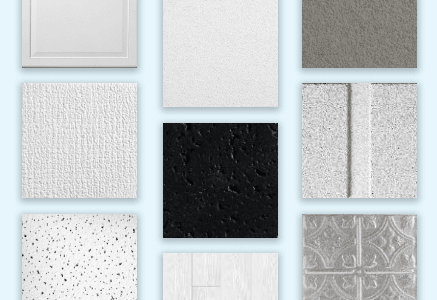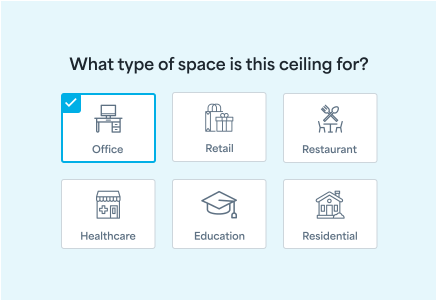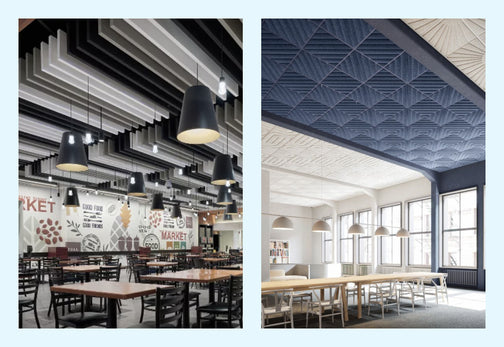Use the terms below as a reference to familiarize yourself with ceiling tiles, their characteristics, and key traits.
Kanopi Ceiling Glossary
A
Absorption:
The ability to convert sound energy into heat instead of reflecting it back.
ANSI:
An independent organization of trade associations, technical societies, professional groups, and consumer organizations. Also formerly known as the United States of America Standards Institute (USASI or ASI) and the American Standards Association (ASA).
ASTM:
A nonprofit organization that establishes standard tests and specifications for construction materials. They’re usually referred to by the abbreviation ASTM followed by a numbered designation.
B
Bevel Edge:
An acoustical tile that turns up at the edge.
BioBlock:
Fungicide treatment used on ceiling panels that retards growth of mold or mildew.
BioBlock Plus:
A performance treatment for Health Zone ceiling panels making them resistant to the growth of mold, mildew, including odor and stains that can cause that growth.
Border Cut:
A cut made on both the ceiling panel and grid at the perimeter of the installation.
C
Ceiling Attenuation Class (CAC):
The measure of a ceiling tile's ability to block sound from traveling to another room or between floors and ceilings. A CAC < 25 is considered low performance; a CAC > 35 is high performance.
Clean Room:
A total room for precision products that has smooth room surfaces to prevent dust collection and air precipitators or filters that keep dust, lint, and airborne pathogens to a specified minimum level.
Cleanability:
The ability for a ceiling tile to be cleaned. Check out Armstrong’s ceiling cleaning recommendations.
D
Disinfectable:
May be disinfected following CDC recommendations and using EPA-approved disinfectant cleaners per Armstrong Disinfecting Guidelines.
F
Fiberglass Panels:
Panels made with a base of high density fiberglass, typically with a vinyl surface. They’re economical, dimensionally stable, easy to clean, and mold and mildew resistant.
Fire Rated:
The UL fire resistance rating of an entire space.
Fire Resistance:
The property of being a fire barrier for a certain amount of time. Acoustical ceiling systems form a membrane that contains fire in a room. Fire-rated assemblies (including ceiling panels, suspension systems, light fixtures, diffusers, and structural components) are given ratings of one, two, three, or four hours as tested per ASTM E 119.
Fissuring:
A way of setting ragged depressions into the face of acoustical tile or panels during manufacture for appearance and acoustical performance.
G
Grid:
The structural system of main beams, cross tees, and associated hardware that hangs from the deck above and supports lay-in, concealed, or surface-attached ceiling panels.
H
Hanger Wire:
Wire used to suspend a grid system from the existing structure and support ceiling tiles or panels.
HumiGuard:
Humidity and sag resistant ceiling tiles that stay flat and minimize replacement of sagging ceilings.
HumiGuard Plus:
Panels designed for superior sag resistance. Recommended for areas subject to high humidity (up to but not including standing water and outdoor applications).
I
Impact Resistance:
In places like gymnasiums, locker rooms, classrooms, corridors, and institutional settings, ceilings could get hit by objects. Impact resistant installations with acoustical lay-in panels typically require retention clips to keep panels in place just in case.
L
Light Reflectance (LR):
A number that indicates the percentage of light that ceilings reflect. A higher light reflectance brightens up a space and boosts productivity.
M
Main Beam:
Load-bearing beams of a suspension system where the parts are mechanically locked together. Provides direct support for cross tees and may support light fixtures and air diffusers as well as the acoustical tile.
Mineral Wool:
A man-made, wool-like material of fine inorganic fibers used for thermal and acoustical insulation.
N
Noise Reduction Coefficient (NRC):
How a tile’s ability to absorb sound is measured. Important in any space where reverberation and noise are issues.
O
Open Plan Office:
An office design characterized by partial-height furniture panels to create cubicles within one large open room.
P
Perimeter Trim:
Right angle shaped grid pieces installed flush to a vertical surface to fit suspended ceiling tiles and grid.
Plenum:
In suspended ceiling construction, the space between the suspended ceiling and the main structure above. Within it is usually a combination of HVAC ducts, electrical and electronic conduits, water pipes, traditional masking sound speakers, etc.
Privacy Index (PI):
A way to rate the speech privacy or lack of speech intelligibility performance of a space.
R
Reverberation:
The persistence of sound in an enclosed space after the source of the sound has stopped. The level depends on both the volume of the room and the amount of installed sound absorption, so small hard surfaced rooms feel louder than large well-treated rooms.
Reverberation Time:
Time required for a sound to decay to one millionth of its original intensity or to drop 60 dB. For example, an RT60 < 1 sec. Is good for good speech intelligibility, whereas RT60 > 2.5 sec works best for symphony music.
S
Scoring:
The process of cutting grooves into the face of acoustical panels to create different decorative visuals and add acoustical benefit.
Scrubbable/Scrubbability:
When cleanliness is a priority, tiles may require cleaning beyond normal maintenance.
Seismic Load:
During an earthquake, the force produced on a structure owing to its acceleration.
Speech Privacy Level:
As defined by ASTM standards: 1) Confidential privacy - speech sounds can be heard but not understood, 2) Normal or non-intrusive privacy – speech can be occasionally heard and understood but is generally non-intrusive, 3) Poor privacy – most nearby conversations can be heard and understood.
Square Edge:
An edge design for acoustical panels that forms a rectangle when viewed from the side.
Suspension System:
A metal grid suspended from hanger rods consisting of main beams and cross tees, clips, splines, and other hardware which support ceiling panels or tiles.
T
T-bar:
Any metal member with a "T" cross section used in ceiling suspension systems.
Tegular:
A functional, stepped edge detail that allows a suspended ceiling panel to extend below the grid, making the grid less noticeable.
V
Vector:
An edge design that provides downward accessibility and a clean upscale visual with a thin 1/4″ reveal, nearly hiding the grid.
W
Washability:
When cleanliness matters, acoustical units may require more than normal maintenance procedures. Some acoustical panels with special surfaces offer superior wash resistance without compromising panel finish integrity. The accepted test procedure is the Washability Test ASTM D4828.



 Thanks for subscribing!
Thanks for subscribing!